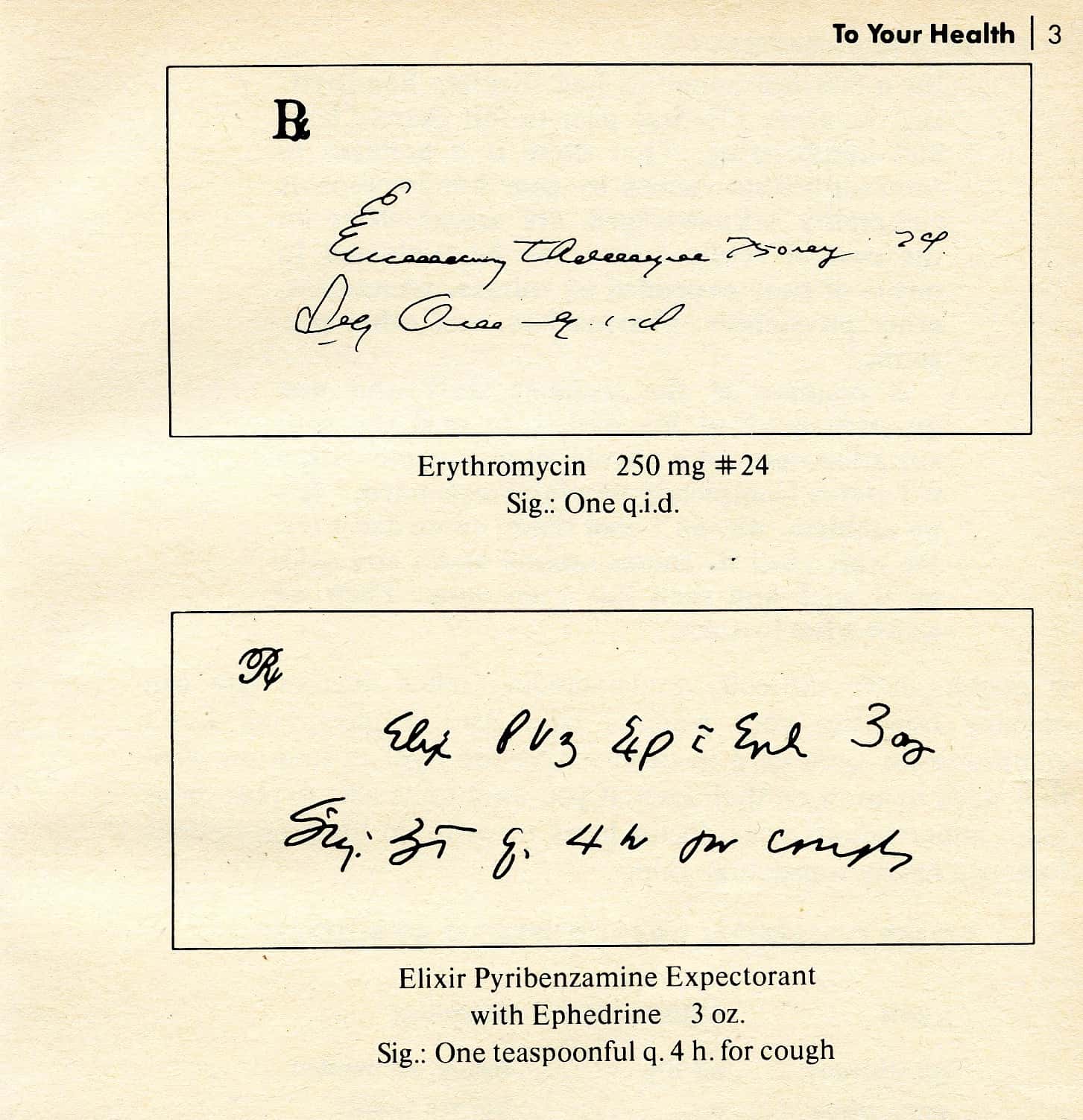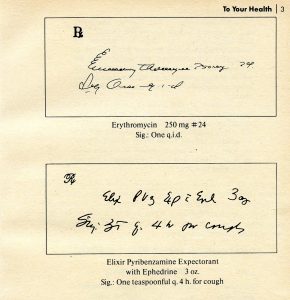
There was a time when a visit to the doctor’s office often resulted in a paper prescription that you would take to the pharmacy. Nowadays there is a strong likelihood that if you need a medication your physician will submit electronic prescriptions directly to the pharmacy of your choice. That may seem efficient, but are their downsides to eliminating paper prescriptions?
Are We Becoming Too Dependent Upon Technology?
Computers, smart phones and electronic tablets have changed our lives. We rely upon these devices to tell us the weather, remind us of appointments and guide us through traffic.
Health professionals have also become dependent upon technology. This is especially true when it comes to writing and filling an electronic prescription.
Many physicians no longer write prescriptions by hand. Now they are selected and transmitted electronically to nursing stations and pharmacies. In theory this should make patients a lot safer.
A reader recently asked this critical question:
Q. Physicians no longer hand patients paper prescriptions; everything is electronic. I seldom need prescription medications, but having paper is good for two reasons. First, I know what medication and dosage was prescribed and can compare that with what is handed to me at the pharmacy. Second, it gives me time to find the pharmacy with the best price without having to have pharmacists call each other to transfer scripts.
Have there been studies on the best prescribing method, paper or electronic?
A. There have been a few studies of this topic. Most focus on benefits for the healthcare system rather than the patient. One study found there was a learning curve of approximately two months (British Journal of Hospital Medicine, Sep. 2, 2015). At first, it took longer for junior doctors to write electronic prescriptions. Later, they took about a minute less.
In addition, a study at a university hospital found that medication errors were less common (but more serious) with electronic prescribing (Journal of Evaluation in Clinical Practice, Oct. 2016). We don’t know, though, if the office will be able to provide you a paper prescription once they have switched to electronic prescribing.
No More Chicken Scratching:
There is some value to electronic prescribing. The illegible scrawl of years past is no longer causing mistakes. We’ll never forget the patient who was supposed to get medicine in his right ear (abbreviated R. ear). Instead the drops were administered rectally because the nurse misinterpreted the doctor’s handwriting.
We have seen prescriptions that would defy the most experienced hand writing expert to decipher. One of our all time favorites was published in the journal Pharmacy Times in 1977. It was written for the antibiotic erythromycin 250 mg. It came out looking like a bunch of es all squiggled together and a dose of 750 mg.
If the patient got the right medicine in the right amount it would have been a miracle. You can see it below along with another totally illegible prescription for Elixir of Pyribenzamine Expectorant with Ephedrine. We published these two examples of illegible prescriptions in our book, The People’s Pharmacy-2 (1980).

Illegible Prescription
Electronic Prescriptions Can Lead to Other Mistakes:
Electronic prescribing has reduced such errors, but it has introduced others. Pull-down menus have led to dosing mistakes. One patient received a massive antibiotic overdose because of the complexity of the user interface.
Research published in the journal Integrated Pharmacy Research and Practice (May 20, 2015) lists some of the problems electronic prescriptions introduce:
“One of the most critical roles for community pharmacists is to recognize and intercept prescription errors before they can reach a patient and cause harm. Thus, new types of ordering errors introduced by e-prescribing are a major concern for pharmacists. A study of 3,850 e-prescriptions generated by providers in three states found that 11.7% contained errors, of which 35.0% were considered potential ADEs [adverse drug events]. In this study, the most common types of errors were omitted information (particularly duration, dose, or frequency), unclear or conflicting information, and clinically incorrect information. Other studies investigating types of e-prescribing errors related to order entry have found that wrong drug quantity, wrong duration of therapy, wrong dosing directions, and wrong dosing formulations occur frequently. Wrong patient and wrong drug errors have also been reported to occur with some regularity.”
What Happens When the Computer Cries Wolf?
One of the biggest problems with electronic prescribing is the excessive alerts that come with each prescription. Doctors are warned about potential interactions with other drugs so frequently that many stop paying attention.
The same thing happens in the drug store. Pharmacists are also deluged with interaction alerts when they fill a prescription.
We originally assumed that computerized interaction warnings would prevent adverse reactions. Health professionals can’t keep all the dangerous combinations and permutations in their heads. That’s why computers could be so valuable in preventing risky mismatches.
Deadly Drug Interactions:
Like the boy who cried wolf, however, the computerized alerts have desensitized health professionals to some truly dangerous interactions. Research has shown that combining the antibiotic co-trimoxazole (Bactrim, Septra) with ACE inhibitor blood pressure medicine like lisinopril or ramipril may lead to sudden death (BMJ, Oct. 30, 2014).
This is the sort of interaction that could easily be overlooked by a busy clinician. Drug interaction programs consider this a relatively low-risk combination and tell prescribers to monitor potassium levels.
The trouble is that together these drugs can raise potassium levels so quickly that it could cause a fatal heart rhythm change. By the time a doctor arranges for a potassium test, the patient could already be in danger or dead.
When Doctors Run Red Lights and Stop Signs:
We have likened ignoring drug interaction alerts to running red lights or not stopping at stop signs. The trouble is that patients are the ones at risk of an accident.
Patients need to realize that interaction warnings are routinely overridden by both physicians and pharmacists. This is a well kept secret, but ask drug safety experts who know a little something about electronic prescriptions and they will readily admit that this is an enormous problem.
Anyone who takes more than one medication should ask both the prescriber and the pharmacist to check for incompatibility. People should also follow Ronald Reagan’s motto: “Trust but verify.”
One way to do this is use an online service such as MediGuard.org. We also offer a free Drug Safety Questionnaire and Medical History form at PeoplesPharmacy.com. Use this to get your health professionals to scrutinize your list of medications.
Electronic devices are convenient, but it is still essential to pay attention and use common sense. Most of us have had the experience of going in circles when the navigation system screws up. Let’s make sure we don’t put our lives in danger by trusting electronic prescriptions without double-checking them.
How To Protect Against Bad Drug Combinations:
If you find it hard to believe electronic prescriptions can be so dangerous, you will want to read the chapter titled “Drug Interactions Can Be Deadly” in our book, Top Screwups Doctors Make and How to Avoid Them. You will also find our “Top 11 Tips for Preventing Dangerous Drug Interactions” at the end of the chapter. Although there is much more information in the book, here are the headings:
- Take a list of all your medicines to your appointment.
- Find out how to take your medicine!
- Check about whether any foods or beverages should be avoided.
- Ask your doctor to check for interactions. Before you leave the office, verify that your physician has reviewed your entire list of drugs and dietary supplements to make sure there are no incompatible combinations. If your doctor is using a computer or handheld device to submit your prescription electronically, ask if there are any drug interaction alerts that you should know about.
- Ask your pharmacist to check for interactions. Do not grab and go when you pick up your prescription.
- Inquire about over- the- counter drugs.
- Go to the Web to check on interactions yourself. The best resource we know of is MediGuard.org.
- Don’t take herbs or dietary supplements without checking for interactions.
- Beware drug-alcohol interactions.
- Inquire about drug-disease interactions. Some medications can make certain conditions worse.
- Check for prescription drug effects on laboratory test results. You will be surprised how many medications can alter lab results.
You will find far more information in the book. We also welcome your comments in the section below called “View Comments.” And please vote on this article at the top of the page.
Citations
- Abramson, E.L., "Causes and consequences of e-prescribing errors in community pharmacies," Integrated Pharmacy Research and Practice, May 20, 2015, doi: 10.2147/IPRP.S64927

